
There are many ways to live and work. One approach is to focus on the themes of intensity, implementation and impact. Different people follow this approach in different ways.
Some people follow this approach in a positive way that can help other people. Some people follow it in a negative way that can hurt other people.
The following sections explore how people may follow this approach in different ways. This can involve them focusing on the following themes.
What are the things you feel intensely about? How do you translate this intensity into action? What may happen as a result of you taking these steps?
Intensity
Some people apply in their intensity in a way that can encourage or inspire other people. They may do this when working as educator, artist, medic, keynote speaker, leader or in another role.
Many books and films depict the lives of people who have applied intensity in positive ways. They have translated this into action to inspire others, save lives or improve life on the planet
As mentioned earlier, some people have applied their intensity in other ways. They have used it to grab power, spread fear or hurt other people.
Let’s return to your own life. What is something that you feel intensely about? What are the reasons why you feel intensely about this? You may believe, for example, that it important to do certain things in life.
If you wish, try tackling the exercise on this theme. This invites you to complete the following sentences.

Implementation
People who feel intensely about things may aim to translate this feeling into action. Some may do this in a positive way that helps people or the planet.
They may aim to encourage others in their role as a parent, educator, medic, scientist, leader or in another role. Some may translate their intensity into writing a book, creating a website or passing on knowledge. Let’s look at some examples of people who aimed to help others.
Alec Dickson, one of my mentors, founded Voluntary Service Overseas and Community Service Volunteers. These enabled thousands of young people to do work that helped people in many fields. It was Alec who gave me my first opportunity to work with people.

Travelling to CSV’s office in London in 1967, I had no idea how my life would change. My lack of education did not matter, said Alec. I had something to give. Alec and CSV helped me to get a job as a housefather in a community for young people. Since that day I have always had the opportunity to do fulfilling work.
Many people reported similar meetings that changed their lives. Here is an extract from an obituary written about Alec after his death in 1994. It was written by Martin Stephen for The Independent.
A Meeting Multiplied Many Times
I met Dickson on many occasions but the abiding memory is of the first: being summoned by him to a meeting at 11.30pm at Sheffield Midland station (he was, as usual, in transit), to discuss my recently announced placing as a volunteer at a northern remand home.
I was barely 17 years old. Though there were clear similarities between my recent experience in a public school boarding-house and life with 50 delinquents in a secure unit, my sense of panic was held at bay only by my sense of shock.
I do not remember his exact words, but he said he trusted me, as he trusted all his volunteers, to do the job, to help someone along the way and to end up just a little wiser after.
It was a turning point in my life and I know from countless conversations that I was one of many who were similarly affected.
Penny Brohn created a remarkable legacy. She helped to give birth to The Bristol Cancer Help Centre. The work done there has helped many people to develop their inner strength and improve the quality of their lives.
As Dr Rosy Thomson says in her book Loving Medicine, the Centre was born out of pain. Penny discovered a cancerous lump on her left breast in the autumn of 1979. An operation under local anaesthetic produced bruising, bleeding and left part of the lump behind.
Doctors advised an immediate mastectomy, but she felt that full recovery depended on more than amputating her breast. Penny became convinced that her illness was the result of her lifestyle.
It was a disease of her whole being, rather than being confined to any single part of her body. Penny eventually met Pat Pilkington, Canon Chris Pilkington and Alec Forbes, a physician. The four people combined their talents to open the Centre in 1980.
This helped to pioneer the way of enabling people to take more charge of their treatment. The work done there helped many people to develop their inner strength and improve the quality of their lives.
Penny Brohn lived many years beyond the initial prognosis. During the 1990s, however, she suffered a spinal bone tumour. After deciding to have conventional surgery, she continued to work but also spent lots of time in Crete.
She lived there until her death in 1999, twenty years after the original diagnosis. Many years later The Centre became known as Penny Brohn UK. This continues to enable both patients and their families to take care of their wellbeing.
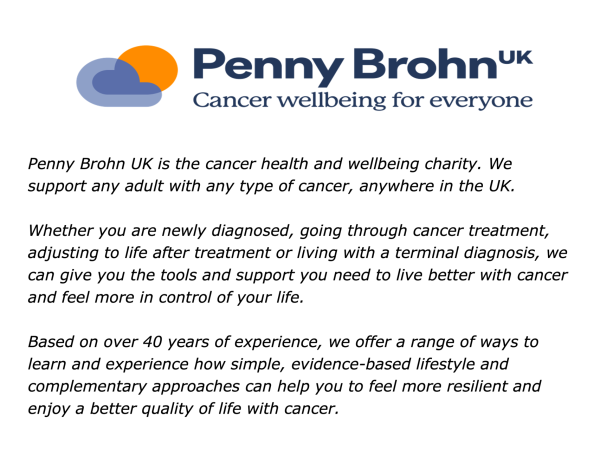
Let’s return to your own life and work. Imagine that you want to translate your intense feeling for something into action. How can you do this in a positive way?
If you wish, try tackling the exercise on this theme. This invites you to complete the following sentences.
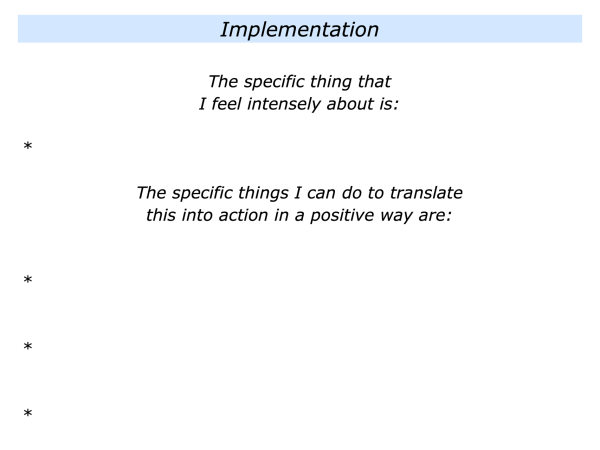
Impact
Some people who feel intensely about things may aim to translate these into action and make a positive impact. Different people do this in different ways.
Some people aim to do this in their daily lives. They see each day as a chance to encourage other people and, when appropriate, help them to shape a positive future.
Many people are happy to take this route. They enjoy helping others and want to plant seeds of hope in their lives and work. They want to do their best to encourage others during their time on the planet.
Some people aim to produce something more tangible. They may aim to do certain kinds of work, write a book, make a film, create a movement, lead an organisation or do other things that deliver positive results.
Some people who feel intensely about things aim to pass on a positive legacy. Different people clarify their aims in different ways. One approach involves them doing the following exercise.
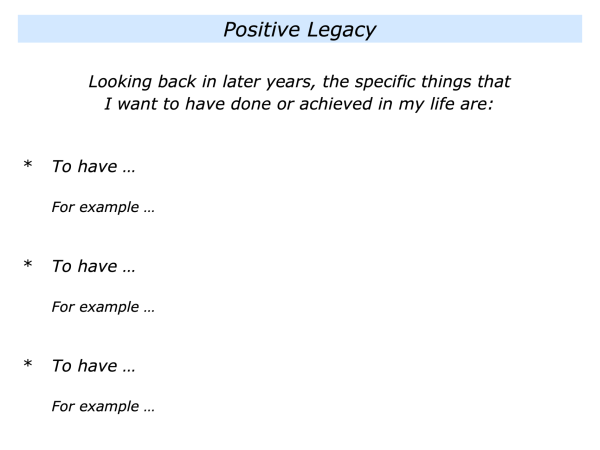
Some people clarify their potential legacy in other ways. One approach is described by Clayton Christensen in the book he wrote with James Allworth and Karen Dillon called How Will You Measure Your Life?
Well-known for his work on entrepreneurship, Clayton also taught his students at Harvard to focus on their core principles. Here are some of the themes he described in an interview he gave the Harvard Business Review.
How Will You Measure Your Life?
I ask my students to find cogent answers to three questions.
How can I be sure that I’ll be happy in my career?
How can I be sure that my relationships with my spouse and my family become an enduring source of happiness?
How can I be sure that I’ll behave with integrity during my life?
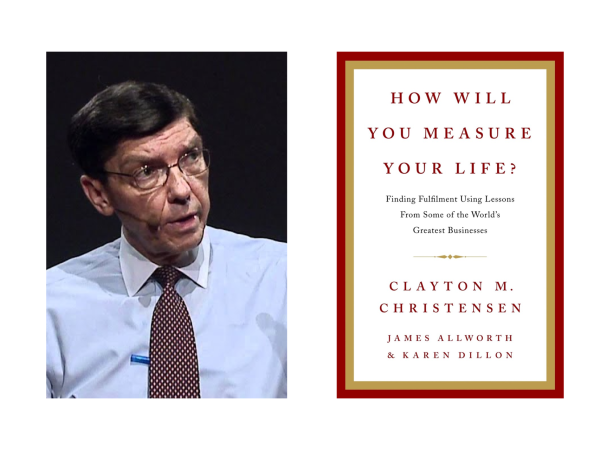

Let’s return to your own life and work. Imagine that you want to translate your intense feeling for something into action. What are the kind of positive results you would like to achieve?
Bearing in mind what you can control in the situation, how can you do your best to achieve these results? What would be the benefits of achieving these – both for yourself and other people.
If you wish, try tackling the final exercise on this theme. This invites you to complete the following sentences.
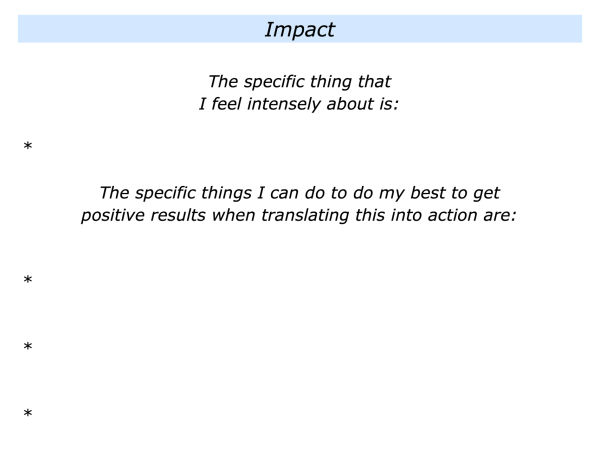

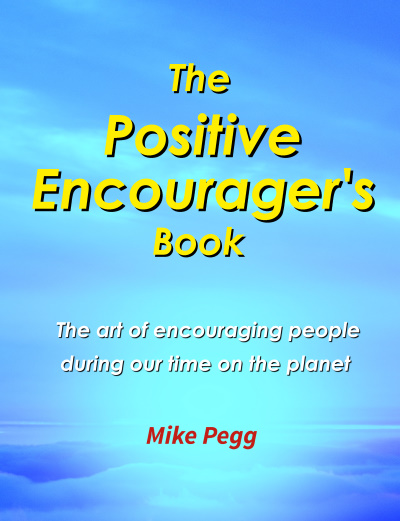
Leave a Reply